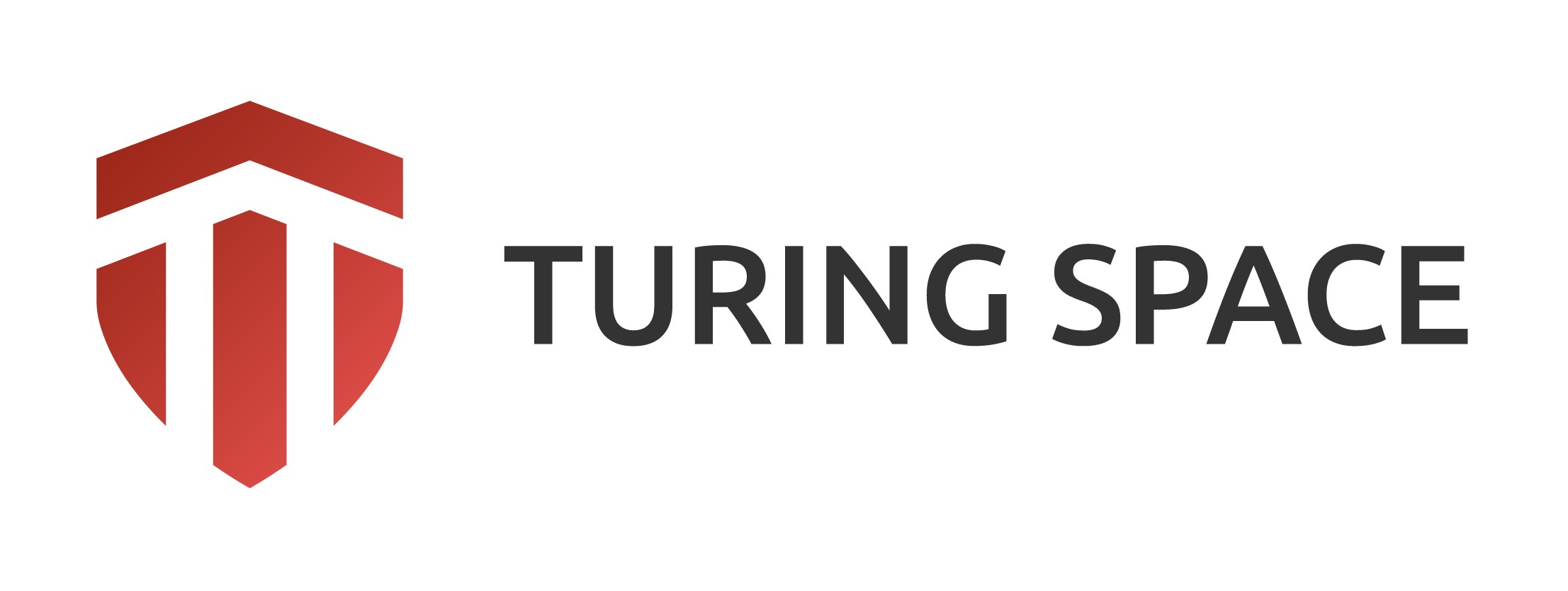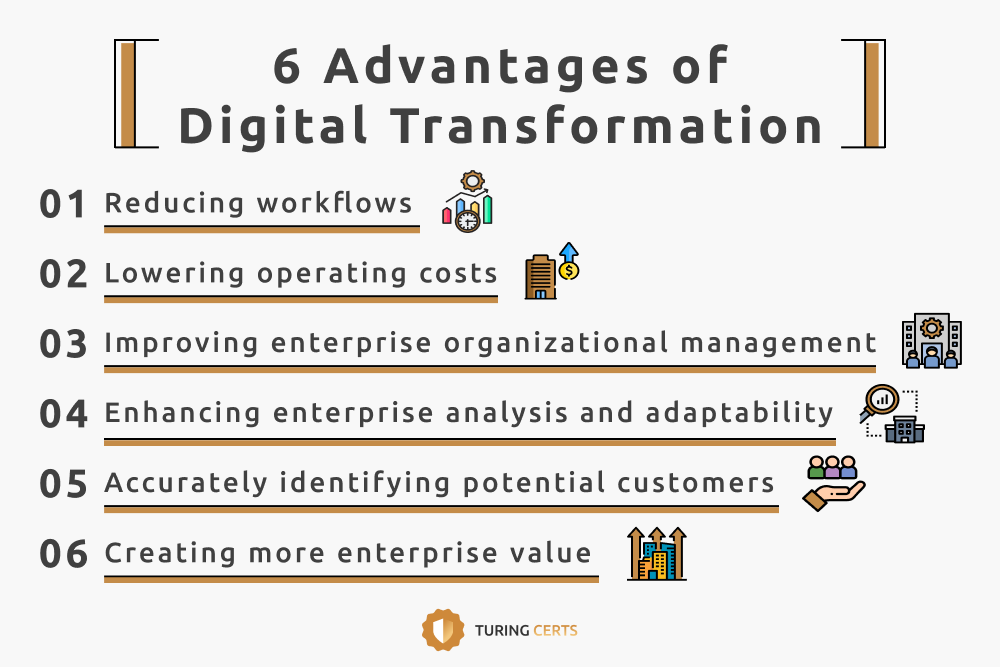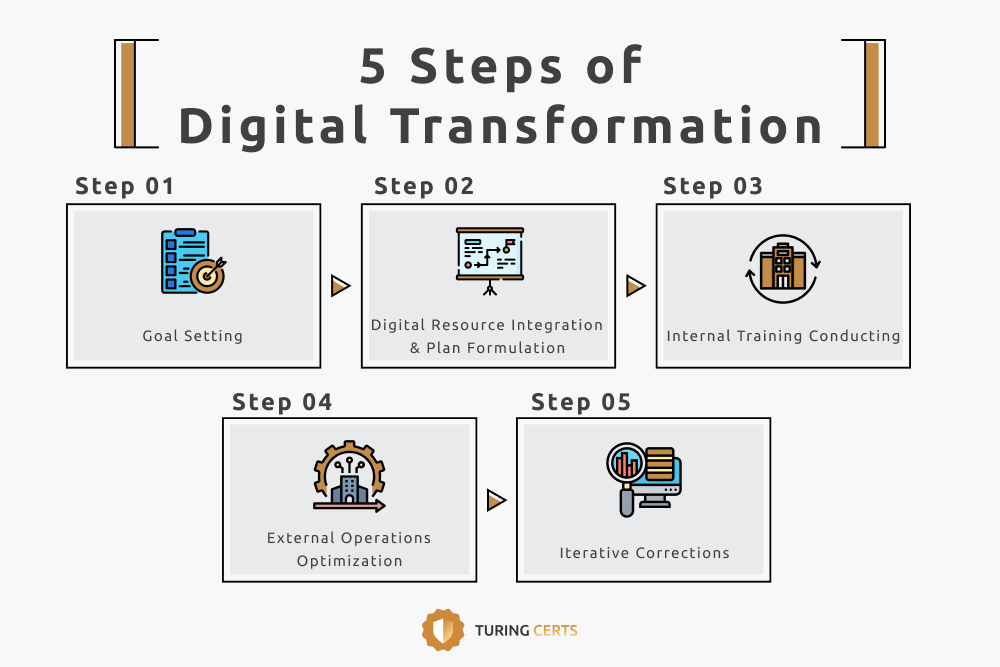Digital Transformation Know-Hows: Mastering 4 Patterns, 5 Steps, and 6 Benefits
2024/5/22
What is Digital Transformation? Why does an enterprise need to do digital transformation? What is the difference between digitalization and digital transformation? This article will introduce you to digital transformation, explain the trends, patterns, and implementation steps of digital transformation, and share digital transformation cases of enterprises to help you better understand what digital transformation can achieve.
Table of Contents
- A. What is digital transformation?
- B. What is digitalization?
- C. Understanding 3 stages of digital transformation
- A. Common digital transformation patterns
- B. Digital transformation planning: 4 major strategies for digital transformation
- C. Digital transformation implementation: 5 steps of digital transformation
IIII. What are the successful digital transformation cases?
- A. European Union Erasmus+|Credential of International Volunteer Training and Participation
- B. Taipei City Government|Credentials of Education and Diploma
- C. Tungs’ Taichung MetroHarbor Hospital|Medical Examination Report and Medical Personnel Certificate
- D. Office of International Affairs at National Taiwan University|Credentials for International Students
- E. Taishin Youth Foundation | Scholarship Certificate, Volunteer Certificate
V. Turing Certs makes your digital transformation top-notch.
I. What is digital transformation? What is the difference between digital transformation and digitalization?
A. What is digital transformation?
Digital transformation refers to a comprehensive change that organizations undergo through the use of digital technologies, affecting internal organizational structures, workflows, corporate culture, and external operational models. This transformation is driven by the need to adapt to modern technological advancements and market demands, aiming to make business operations more efficient, optimized, and competitive.
You might wonder: Does digital transformation simply mean digitization for businesses? What is the difference between digitization and digital transformation?
B. What is digitalization?
Digitization means to introduce digital technology tools into the internal workflow of an enterprise, using digital tools to reduce the time, labor, and resource costs consumed by the enterprise in the workflow.
If the introduction of digital tools is only initially completed, it can only be said to be the optimization of internal work processes but has not yet reached the transformation of the overall internal and external operating model of the enterprise. Digitalization is only the most basic part and also the first stage of digital transformation.
C. Understanding 3 stages of digital transformation
To achieve complete digital transformation, companies must undergo the following 3 stages:
1. Digitization: Introduce digital tools
Digitization is the least difficult of the three stages of digital transformation. It only involves the introduction of tools to simplify the company’s workflow and reduce operating costs.
There are many examples of digitization. For example, converting paper data/documents into digital format and storing them in a cloud system for electronic management is information digitization. Introducing an online human resources management system to facilitate the retention and management of employee information, is a kind of enterprise digitization.
After achieving the initial stage of digitization, companies can enter the next stage, Digital Optimization, further applying digital tools to corporate operations and optimizing business models and business strategies. There are certain technical thresholds for deepening the application of digital tools; therefore, digital optimization is more difficult than digitization.
For example, digital analysis of customer consumption data on e-commerce websites, optimizing website experience, and adjusting sales strategies; using digital tools to collect statistics, analyzing consumer needs, and applying them to product development are all considered a type of digital optimization.
3. Digital Transformation: comprehensively improve corporate mindset
Digital Transformation is the most time-consuming and difficult to achieve among the three stages. It is not only the use of digital tools for internal management and external business strategies of the enterprise but also the reconstruction of the overall organizational structure and culture of the enterprise and the change of corporate thinking.
Taking existing customers and potential customers as the core and starting point of digital transformation, and fully integrating corporate operating strategies, thinking, models and digital tools is the most important aspect of digital transformation.
II. Why do digital transformation? Introduction to the trends and advantages of enterprise digital transformation
A. Trends in digital transformation
1. Development of 5G, Artificial Intelligence (AI), and Artificial Intelligence of Things (AIoT)
After the innovation of 5G network communication technology, its high efficiency and zero-delay characteristics have accelerated the popularity of the Internet of Things (IoT) – physical devices can be connected through the digital network, allowing digital technology to be closely integrated with consumers’ lives. Inseparable, many emerging digital consumption models have emerged.
In addition, with the development of AI, the concepts of AI and IoT can be combined to form a new digital technology application AIoT. Enterprises can conduct in-depth analysis through the AIoT. Big data uses data to make more accurate business judgments and decisions and provide customers with the best service experience.
Without digital transformation, it will be difficult to seize market opportunities through digital technology. Facing the importance of digital transformation can enhance corporate competitiveness in the digital era.
2. Impact of the post-pandemic era
Corporate transformation is also related to the impact of the post-pandemic era.
After the COVID-19 epidemic, the boundaries between physical and online consumption have become more blurred, and work processes and models have begun to be dominated by remote and digital networks. According to the “2022 Taiwan SMEs Transformation Current Situation” proposed by the Information Industry Strategy Association. The “Situation and Demand Survey” pointed out that after the epidemic, more than 90% of Taiwan’s small and medium-sized enterprises have begun to invest in preliminary digital development and gradually moved towards digital transformation.
B. Six advantages of digital transformation
What specific advantages can companies bring when they implement digital transformation?
📌 Reduce work processes and improve production efficiency
Through digital transformation, enterprises will introduce digital tools to reduce unnecessary work processes between departments and improve production efficiency. For example, the traditional work clocking in, medical leave, and official document approval can be unified into an online system operation, which not only facilitates management but also greatly reduces the labor and time costs consumed in this process.
📌 Lower operating costs and increase corporate profits
Following the above, once a company’s labor costs are reduced, work processes are streamlined, and production efficiency is improved, it will naturally drive the company’s profit growth and reduce unnecessary operating costs in the past.
📌 Improve enterprise organizational management
The larger the scale of an enterprise organization, the more systematic management it needs. We can use digital transformation to achieve this. Common application examples include enterprises use cloud human resources management systems to track employee performance and employee training records, etc.
📌 Enhance enterprise analysis and adaptability
Through the application of digital technology, enterprises can better predict and analyze the future view of the market, thereby proposing more accurate business strategies and improving their adaptability to changes in the business environment.
📌 Discover potential customers and enhance customer loyalty
Digital transformation can improve product development and service quality, tap more potential customers, and enhance the loyalty of existing customers.
For example, e-commerce operators analyze consumers’ consumption behavior through the data collected from the content management system, summarize the consumption patterns of target customer groups (TA), and then optimize products and services. This is also the purpose of the Customer Relationship Management (CRM) system which has become very common in recent years.
📌 Promote business model transformation and enable enterprises to grow rapidly
Enterprises can expand and develop new business models through real-time analysis of market trends. This is also the most important purpose of digital transformation. Through business model innovation, more corporate value can be created.
III. How to plan digital transformation? What are the strategies and steps for digital transformation?
A. Common digital transformation patterns
1. Workflow Transformation
Workflow transformation is the foundation of digital transformation and the most common way of digital transformation. Companies can simplify or change existing workflows through the introduction of digital tools.
📍Example: Amazon, the leading e-commerce company, is also developing its own logistics system. They use a fully automatic mobile robot “Proteus” to transport packages, improving traditional warehousing operations, reducing operating risks, and saving labor expenses.
2. Product/Service Transformation
Product/service transformation is the digital transformation direction that many companies focus most on. Product sales and service provision will directly affect the company’s revenue. If the product and service provision are transformed appropriately, there is an opportunity to bring huge profits to the company.
📍Example: The catering industry has changed the traditional way of providing meals through online reservations, online ordering systems, and cooperation with delivery platforms, thereby increasing turnover and service quality.
3. Business Model Transformation
Business model transformation is not just a change in the way of providing products or services, but also changes in corporate business strategies along with digital transformation. This kind of transformation will increase turnover as well as expand new customers and new markets.
📍Example: The music streaming platform Spotify initially positioned itself as an online music sales and music player. Through the application of digital technology, algorithm mechanisms, it creates highly personalized services, combining premium members and ads revenue sharing system has successfully carried out digital transformation, not only transforming the original business model but even changing the music market.
4. Organizational Culture Transformation
Digital transformation can achieve the reshaping of organizational culture, which is the transformation of corporate organization/culture. To put it simply, it is to establish a good corporate culture and values through digital transformation and improve the communication efficiency and collaboration capabilities within the organization.
📍Example: Microsoft once faced a development downturn. Microsoft’s current CEO Satya Nadella introduced and developed AI, re-formulated its operating strategy, and gradually improved the internal atmosphere through close employee training and cross-department cooperation. The company has successfully taken the lead in the artificial intelligence market.
B. Digital transformation planning: 4 major strategies for digital transformation
After reading the above digital transformation patterns, if you are still thinking about how to start the digital transformation, you may wish to take a look at the following four digital transformation planning strategies.
1. Consider using digital tools
Digital transformation can start by considering the current digital tools. You can first think about what digital tools you currently have, what aspects of business operations these tools can help, and what kind of digital tools you still lack compared to other competing companies.
2. Prioritize customer experience
Digital transformation is also in response to market demand, so digital transformation planning must prioritize providing customers with a good service experience.
3. Use data for evaluation
The results and current status of corporate operations will be presented most objectively through data. If the company wants digital transformation to not just stay at the level of digitization, making a proper assessment of data analysis is an important consideration for digital transformation.
4. Regularly observe market trends and maintain an open mind
Rigid business thinking will hinder the practice of digital transformation. We can adjust the direction of digital transformation by always paying attention to market trends.
C. Digital transformation implementation: 5 steps of digital transformation
STEP 1: Set transformation goals
If an enterprise would like to implement digital transformation, it must first start by setting transformation goals. Just like writing a business plan must have goals, we should think about what specific goals the company hopes to achieve after digital transformation. How likely is it to be achieved?
STEP 2: Integrate digital resources and formulate a transformation plan
After the enterprise has the goal of digital transformation, it can begin to inventory and integrate the current internal resources and budgets; meanwhile, start formulating a digital transformation plan to plan the transformation stages and timeline.
STEP 3: Execute internal transformation
The first step in the formal implementation of digital transformation will be internal transformation. In addition to the introduction of digital tools, it is also important to train employees to keep up with the development of emerging digital technologies. Through internal training, different departments can be familiar with the application of digital tools, so as to improve work efficiency, reduce work processes, and also cultivate a good collaborative atmosphere and tacit understanding of the team.
STEP 4: Adjust external operations
While implementing digital transformation within corporate organizations, we can combine digital technology with external operational optimization to create new business opportunities and expand the possibilities of more business models.
STEP 5: Data analysis and optimization
Digital transformation does not happen overnight, and iterative corrections and adjustments are often required during the process. We can optimize the direction and content of digital transformation by analyzing the information and data collected after digital transformation.
IIII. What are the successful digital transformation cases?
A. European Union Erasmus+|Credential of International Volunteer Training and Participation
As the largest international organization for economic cooperation in Europe, the European Commission has applied digital transformation to the large-scale transnational fund project “Erasmus+” that supports youth, education, and sports and achieves excellent results.
The Erasmus+ plan introduces the Turing Certs System to create a unified digital management of volunteer training certificates, youth university certificates, and academic experience certificates. It uses blockchain technology to ensure the integrity and authenticity of digital certificates. It integrates the transnational characteristics of 27 European member states to create a common international certificate format and management model and promote a seamless and efficient cross-border verification process.
Through the Turing system, Erasmus+ successfully reduced 50% of printing costs, 40% of certificate issuance time costs, and 70% of mailing failure rates. With the assistance of digital transformation, it successfully achieved two goals, “International Youth Talent Exchange” and “Higher Education Training Reform”.
B. Taipei City Government|Credentials of Education and Diploma
When it comes to the digital transformation of government agencies, among the successful cases in Taiwan, the Taipei City Government must be mentioned.
In response to the trend of digital transformation, the Taipei City Government has specially established the “Digital Business Center @ Taipei”, held the “Taipei Industrial Digital Application Expo” in 2023, and also released the “Taipei City Education Policy White Paper” to promote the digitization of the education industry.
At the same time, the Taipei City Government introduced the Turing Certs System to fully digitally manage the relevant certificates or credentials of 31 affiliated first-level agencies, 12 district offices, 112 affiliated second-level agencies, 236 schools at all levels, and 14 kindergartens. In conjunction with digitalization policies, we assist in the digital transformation of the education sector and move towards the vision of a “Smart City”.
C. Tungs’ Taichung MetroHarbor Hospital|Medical Examination Report and Medical Personnel Certificate
Medical data is special personal information and is strictly regulated by medical laws and requires careful control. Therefore, it is not easy for medical institutions to undergo digital transformation. Speaking of medical institutions, people often think of a large number of paper documents such as medical records, examination reports, and medical documents, which are far from digitization and digital transformation.
However, Tungs’ Taichung MetroHarbor Hospital, the only medical institution in Taiwan that has passed JCI certification six times, is a very successful case of digital transformation in the medical industry.
In order to pursue paperless medical operations, Tungs’ Taichung MetroHarbor Hospital cooperated with Turing Certs and introduced the Turing system, successfully converting health examination reports, work physical examination reports, hospital medical personnel certificates, medical ethics appointment letters, and internal nurse assessments into digital management.
Digital management not only greatly reduces the time and manpower required in the previous work process, but also improves the security of medical information regulated by regulations under the strict verification mechanism of the Turing system, successfully achieving digital transformation goals, “smart medical care × contactless medical care”.
D. Office of International Affairs at National Taiwan University|Credentials for International Students
Besides government agencies and the medical industry, National Taiwan University, the head of Taiwan’s tertiary institutions, is also committed to digital transformation. The Office of International Affairs at National Taiwan University was established in 2007. It is responsible for the planning, development, and promotion of internationalization strategies, creating opportunities for transnational higher education cooperation, and is the driving force that enables National Taiwan University to deepen international academic exchanges.
Due to the frequent movement of international higher education talents, the issuance, collection, and verification of documents and certificates related to academic exchanges not only takes a long time, but also the cost of international registered postage is high. Therefore, the Office of International Affairs chose the Turing Certs System to digitize the certificate of degree, certificate of course attendance, and Internship of international students. The system is also used in the “National Taiwan University International Mentorship Program” to assist foreign students in finding jobs in Taiwan. This not only improves foreign students’ academic satisfaction, but also allows National Taiwan University to have stronger relationships with international partners.
E. Taishin Youth Foundation | Scholarship Certificate, Volunteer Certificate
Taishin Youth Foundation is the country’s first and only public welfare platform for junior and senior high school students to volunteer. It encourages young people to participate in volunteer services and cultivate good character and civic qualities. It actively integrates academia, the media, secondary schools across the country, and charity organizations to bring the greatest benefits to society. So far, more than 80,000 young people have been encouraged to participate in volunteer activities.
Taishin Youth Foundation has chosen the Turing Certs to issue digital certificates of service history to all participating youths. The certificates can not only update records interactively at any time but can also be paired with physical activities to create new activity experiences, and also let many students easily share their volunteer experience on LinkedIn and portfolios.
V. Turing Certs makes your digital transformation top-notch.
Turing Space is a TrustTech startup founded by Jeff Hu in 2020, dedicating to addressing the complexity of certifications among industries worldwide. We build up a borderless digital trust network with blockchain technology, advancing global digital transformation, aiming to become the cornerstone of international trust transmission.
Turing Certs can provide enterprises with the highest quality digital transformation services, assisting enterprises to digitize documents and manage and receive credentials through “blockchain real-time verification”, “multi-language interface”, and “4-stage high privacy permission settings”. It can also support flexible system functions such as “customized verification page” and “customized template design”, allowing enterprises to have the highest-standard digital management system.
What digital transformation advantages can Turing Certs provide you?
✅ Achieve paperless enterprise and save the cost of paper printing
✅ Information is digitized, systematic, and easy to manage, making business operations more efficient
✅ All digital credentials must be strictly verified to enhance information security
✅ Provide real-life customer service support so that even novices with digital tools can adapt quickly
✅ Assist enterprises to easily introduce digital tools and promote digital transformation
For the highest quality digital transformation services, inquire about Turing Certs now!
![]() Media Contact|[email protected]
Media Contact|[email protected]













